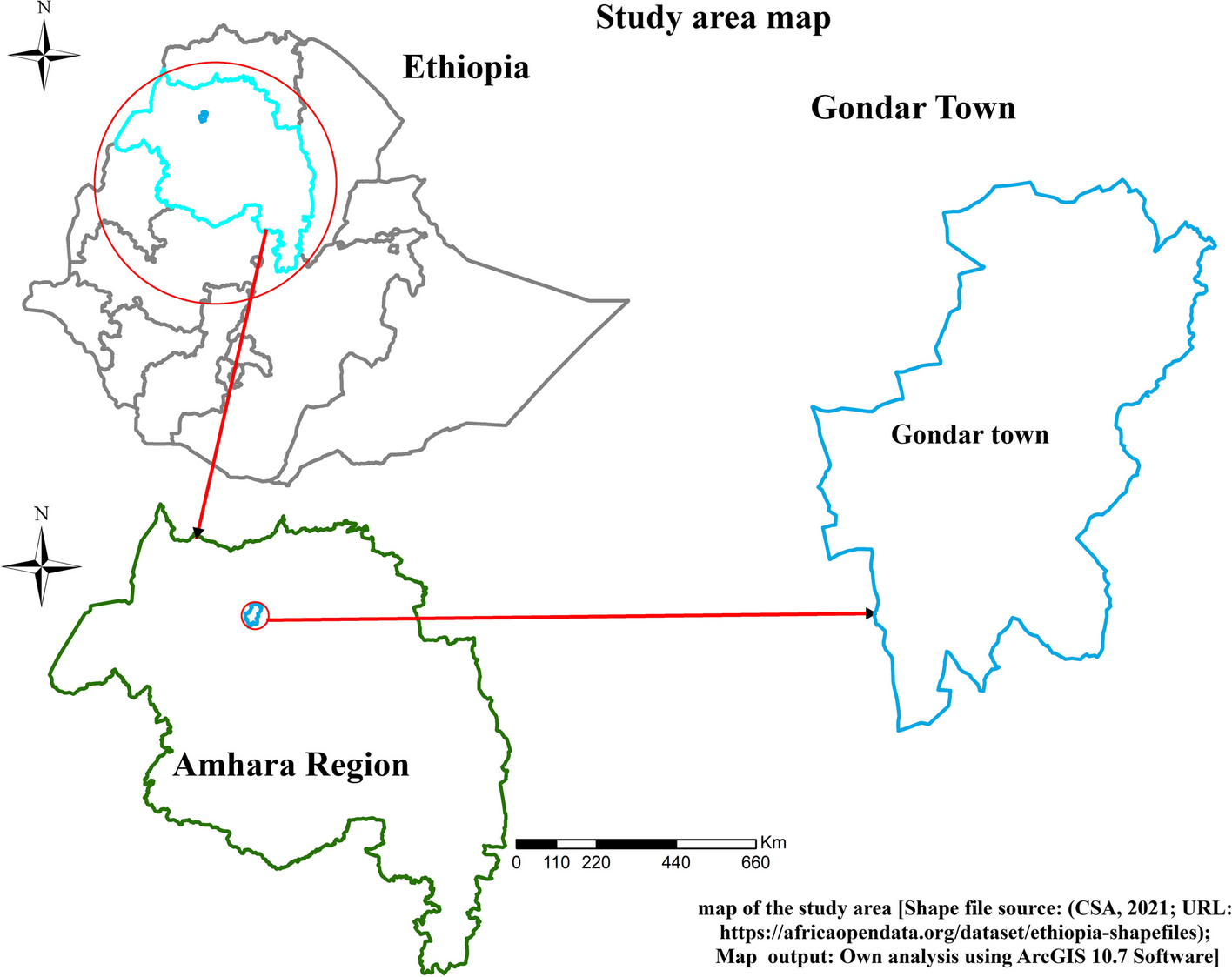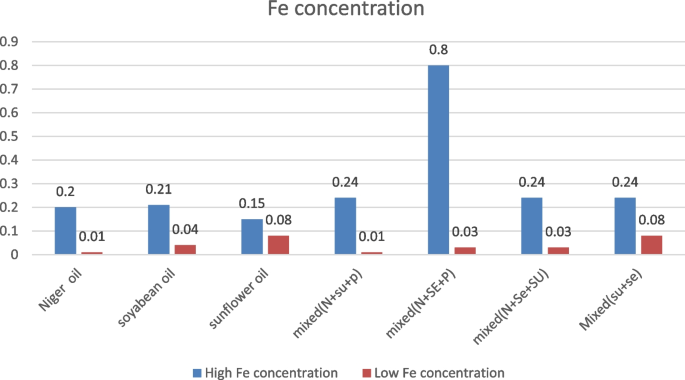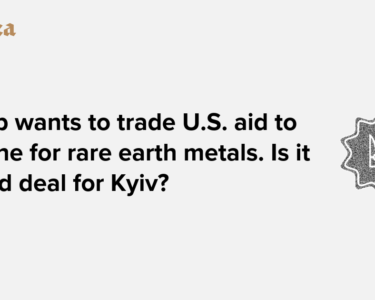Determining the concentration of metals in edible vegetable oil is crucial since they play significant roles in various metabolic processes in the human body. However, excessive intake of these metals can be toxic. This study analyzed the levels of five metals (Fe, Cu, Zn, Pb, and Cd) in edible vegetable oil samples using Flame Atomic Absorption Spectroscopy (FAAS).
Levels of heavy metals in edible oils
The concentration of the selected metals in the edible oil samples was determined using flame atomic absorption spectroscopy (FAAS) after preparing the necessary calibration curves. The microwave digestion system was chosen for its high accuracy in terms of both time and recovery values. Each sample was analyzed in triplicate. The recovery values for the microwave digestion method were nearly quantitative, and the relative standard deviations for all investigated metals were less than 15%. The results were compared with WHO/FAO and NAFDAC standards and showed good agreement with the certified values, except for lead and cadmium in some oil samples. The median concentrations for unspiked and spiked oil samples in this study are provided in Table 7.
Copper
In the present study, the sample’s Cu content ranged from 0.003–0.06 mg/l (Fig. 3). Mixed oil has a high concentration of copper metal as compared to soybean and sunflower oils. The value was found to be lower than the maximum allowable concentration limit set by the Food and Agriculture Organization of the United Nations (FAO) and the World Health Organization (WHO) (0.1 mg/l) [39,40,41,42,43]. This implies a reduced health risk and preserved shelf life as well as good sensory quality of the oil for consumption. In addition, this level of concentration will prevent potential acute and chronic toxic effects associated with copper contamination. The result in this study was lower than that was reported in similar studies conducted in Spanish (0.02–0.33 mg/kg) [44], Italy (12.71–50.5 mg/kg) [45], Croatia (0.15–1.5 mg/kg) [46], Turkey (0.05–0.71) mg/kg [14], Saudi Arabia (0.035–0.286) mg/kg [11], Turkey (0.71–0.05 mg/kg) [14] and in China (0.214–0.875 mg/kg) [15]. The copper values in the current investigated oil samples are higher than from a study conducted in Riyadh that range from 0.001–0.081 mg/kg [47]. These differences might occur due to several factors. First, different countries and regions may have varying agricultural practices, including the use of copper-based pesticides or fertilizers, leading to differences in copper levels. Secondly, the methods used to extract and refine vegetable oils may yield oils with different copper concentrations where the current study used oil products processed by both cold-pressed and solvent extraction method. Thirdly, the instrument and solvent used might be the reason for the variation where the current study used an atomic absorption spectrometer (FAAS) for detection of the metal content, whereas other studies use different instruments like inductively coupled plasma atomic emission spectrometry (ICP-AES), chemometric identification stripping voltammetry, and near-infrared spectroscopy (NIRS) [48]. Although excessive copper intake is toxic, it plays various essential roles in numerous biological systems within the human body [49,50,51]. Children with copper deficiency may experience osteoporosis, leukopenia, and hypochromic anemia, while chronic copper poisoning can result in Wilson’s disease [49,50,51].
Iron
Fe was found within the range of 0.01–0.8 mg/l with a median value of 0.15 mg/l (Fig. 4). The highest Fe concentration (0.8 mg/l) was observed in locally produced mixed oil. The value was found to be lower than the maximum allowable concentration limit set by FAO and WHO (1–1.5 mg/l) [39,40,41,42,43] implying safe quality for consumption without a health risk. The Fe concentration in this study was lower than other studies in Saudi Arabia (17.3 – 57.8 mg/l) [21], China (16.2–45.3 mg/l) [15] and (7.78–28.93 mg/l) [52]. Fe value has been reported to be higher than our values in this literature (15.31 and 3.39 µg/g) [13, 45, 46]. The possible reason for the variation might be the iron content in the soil itself differs depending on geographical location and soil composition. The use of iron-containing fertilizers or amendments can influence the iron content of plants. Fertilizers may be applied to enhance plant growth and nutrient uptake, potentially impacting the mineral composition of the plants, including iron levels. Additionally, processing conditions, storage and handling are other contributing factors. Iron is a well-known essential mineral, integral to hemoglobin. It aids in the oxidation of fats, proteins, and carbohydrates, helping to maintain body weight, whose deficiency can lead to anemia [53,54,55].
Zinc
The sample’s zinc content varied from 0.07 to 0.8 mg/l, with a median value of 0.25 mg/l (Fig. 5). Its concentration is acceptable as compared with the range of the maximum allowable concentration limit set by the FAO and WHO (1–1.5 mg/l) [39,40,41,42,43]. Zn concentrations in this investigation were lower than other results reported by numerous researchers: is 0.955–3.10 mg/l, 3.08–1.03 mg/l, 3.58–9.54 mg/l, [14, 21, 44, 52, 56] and inline concentration (0.742–2.56 mg/l) in a study conducted in China [15]. The variations in the concentration of zinc across studies might be influenced by a combination of factors related to plant biology, agricultural practices, processing methods, and storage conditions. Additionally, different geographical sample places, different types of instruments used for metal detection, the varied soil’s Zn content, and human activity might all be related to this difference. Zinc plays a crucial role in most human metabolic processes, and deficiencies can lead to immune issues, growth delays, loss of appetite, and skin changes. Conversely, excessive intake of zinc can cause nausea, vomiting, appetite loss, abdominal cramps, diarrhea, headaches, and weakened immune function [15][57, 58].
Cadmium
Cadmium content was found to be in the range of 0.08–0.18 mg/l (Fig. 6). In our study, 25% of oil samples were higher than national, international, and legal limits recommended by FAO/WHO, which that is 0.05 mg/l (Codex S 2011) [39,40,41,42,43]. This indicates broader contamination issues, which imply the oil might pose serious health risks and regulatory challenges. The cadmium level of this study is lower than studies those conducted in China, Iran, and Nigeria (2.64–8.43 mg/kg, 1.87–8.58 mg/kg, 0.34–2.77 mg/kg) [15, 52, 59]. The difference in concentration may be caused by the process applied in the analysis, the analytical solvents used, the digestion method, or the equipment or instrument used for detection. In addition to being a naturally occurring element in soil, cadmium is also widely distributed in the environment due to human activity. Its poisoning can result in cancer as well as problems with the kidneys, liver, skeletal system, bone demineralization, and respiratory problems [60,61,62,63].
Lead
In our study, lead concentrations varied from 0.003 to 0.27 mg/l with a median value of 0.07 mg/l as shown in Fig. 7. The results of this investigation were lower than other findings in Iran (4.56–15.82 mg/l) [52] and reported in Turkey [14] and higher than those from studies conducted in Saudi Arabia, China, Turkey, and Nigeria (0.011–0.017 mg/l, 0.03–0.01 mg/l, 0.01–0.034 mg/l, 0.009–0.018 mg/l) [14, 15, 21, 59]. Lead concentrations in 17% of the oil samples were found to be higher than national, international, and legal limits recommended by FAO/WHO, which is 0.1 mg/l [39, 42, 43, 64]. The majority of the study’s oil sample results fall below the permissible limit compared to prior published values. The variation in lead concentration in oil samples can be attributed to several factors. The methods used to extract and refine vegetable oils, instrumentation, and processing techniques, especially refinery, may influence the concentration difference in the oil samples. On the other hand, lead contamination can occur during storage and handling of the oil if it comes into contact with lead-containing materials. Variations in quality control measures during the production of vegetable oils might also be the reason. It can harm the developing fetal neural systems by crossing the placenta [65,66,67]. Lead poisoning can be acute or chronic, and it damages the kidneys, liver, heart, and vascular and immunological systems [68, 69]. Even at comparatively modest levels, lead can have serious health impacts. It can harm the developing fetal neural systems by crossing the placenta [65, 67].
A Kruskal–Wallis test was conducted to examine the mean differences of iron, lead, copper, zinc and cadmium content in the oil samples according to the types of ingredients of oil as shown in Table 8. In the seventeen oil samples, the Kruskal Wallis result showed that there is a statistically significant difference (Chi square = 14.513, 17.266) with d.f. = 6 and probability = 0.0244, 0.0084) for copper and zinc with ingredients of oil. But no significant differences (Chi square = 11.037, 10.053, 4.127, with d.f. = 6 and probability = 0.087, 0.1225, 0.6595) were found among the samples in cadmium, lead, and Iron. Cadmium and lead contamination are hardly associated with edible oil processing; it is mostly caused by environmental exposure rather than process-related [70]. Its presence can be caused by deposition or bioaccumulation in the soil or water due to pollution [71]. Cadmium and lead (Pb) can come from industrial emissions, fuel combustion during the refinery process, and packaging materials like a plastic stabiliser and colorants [5, 71]. It is also well known to be heavily contaminated due to the plantation’s use of phosphate-based fertilizer. They are recognized as acute and chronic poisonings that can impair the immune system, kidneys, liver, and heart [15].
A significant statistical difference was shown in copper and zinc among the samples based on their ingredients. This might be because of the oil processing method, and the natural content of metals in the oil species may affect the concentration of copper and zinc. Zinc is involved in most metabolic pathways in humans and serves as a cofactor for many enzymes. Copper is an essential trace metal important for both physical and mental development in humans. It is usually found in many food types, particularly vegetarian foods such as nuts, seeds, and grains, unlike lead and cadmium.
The limitation of the present study is that the risk associated with the detected levels of metals was not assessed, and the potential risk factors for the findings were not investigated. Additionally, the study focused exclusively on vegetable oil products, which may make it challenging to generalize the results to other types of products consumed in Gondar City.
The study also has several strengths. Firstly, the data collected was both well-representative and of high quality. Secondly, to the best of our knowledge, this is the first comprehensive investigation into the levels of heavy metals and essential minerals in the study area. Thirdly, the study examined a diverse range of edible vegetable oils, providing a thorough assessment of their chemical quality.









